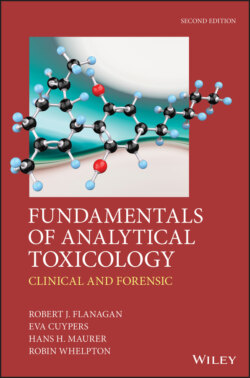Читать книгу Fundamentals of Analytical Toxicology - Robin Whelpton - Страница 54
2.3.1 Sample collection and preservation
ОглавлениеIn general biological specimens should ideally be stored at 2–8 °C before transport to the laboratory. Exceptions to this include hair, nail, and filter-paper adsorbed DBS. Dried blood stains and other dried forensic specimens may of course be handled similarly (Schütz et al., 2002).
Each specimen bottle should be securely sealed to prevent leakage, and individually packaged in separate plastic bags. Particular attention should be paid to the packaging of samples to be transported by either post, or courier in order to comply with current health and safety regulations. Sample volumes or amounts smaller than those indicated in Tables 2.4 and 2.5 are often sufficient to complete the analyses required. Submission of very small samples may, however, result in reduced sensitivity and scope of the analyses undertaken, but nevertheless such samples should always be forwarded to the laboratory. Any residual specimen should be kept at –20 °C or below until investigation of the incident has been concluded.
In post-mortem work, the use of disposable hard plastic (polystyrene) tubes is recommended. If these are not available, then containers with secure closures appropriate to the specimen volumes should be used. Some laboratories provide specimen containers for collecting post-mortem blood and urine specimens. It may be important to note if urine was obtained by use of a catheter. Suitable packaging for sending specimens by post may also be supplied. When death has occurred in hospital and poisoning is suspected, any residual ante-mortem specimens should be obtained as a matter of urgency from the hospital pathology laboratory (not only chemical pathology and haematology, but also immunology, transfusion medicine, and virology departments may be a source of such specimens) and submitted for toxicological analysis in addition to post-mortem specimens. Recording the date and time of collection of such samples is important. Note that the availability of ante- or peri-mortem specimens does NOT negate the need to collect post-mortem specimens.
All organ and tissue samples, and any tablet bottles or scene residues, should be placed in separate containers to avoid any chance of cross-contamination. Sampling through tissues containing high concentrations of an analyte may lead to contamination of the sample. On the other hand, toxicological analysis of samples from an embalmed body, formalin-fixed specimens, or even on tissue from microscope slides may be requested. Clearly, concentrations of any drugs or metabolites that survive in such specimens are likely to have been altered by the embalming or fixation process. Formaldehyde is highly reactive, and the identification and the evaluation of possible analyte degradation products and/or formaldehyde derivatives may be helpful (Nikolaou et al., 2013; Takayasu, 2013; Ameline et al., 2019).
Sample integrity is of prime concern if there are medico-legal implications because evidence may have to be produced in court. Precautions to ensure sample integrity include: (i) proper sample labelling, (ii) use of tamper-proof containers, (iii) collection of samples such as hair, nail, and femoral blood before opening the body and documenting the fact, and (iv) proper accompanying documentation (chain-of-custody documents). Samples collected for clinical purposes (or even for the coroner) are often not of ‘evidential’ quality, but such samples may be all that is available. DNA testing may be used to establish the origin of certain samples if there is concern over sample integrity.
